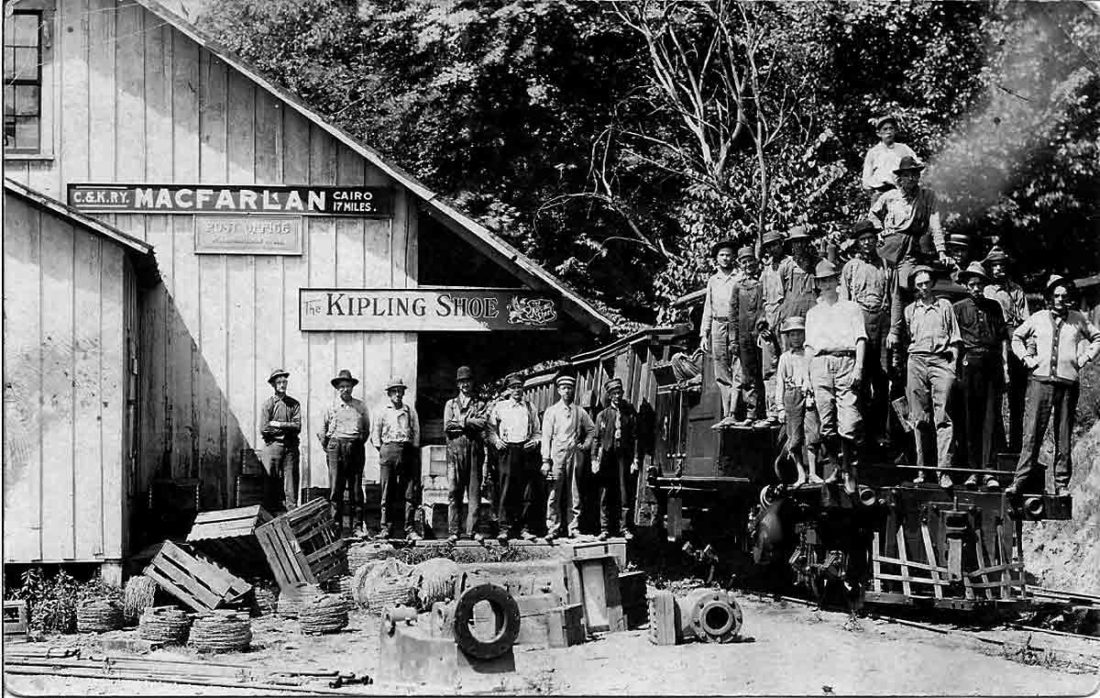Look Back: Ritchie County mines, railroad fade into history

Photo provided by the Ritchie County Historical Society A train of the C.&K. RY. (Cairo and Kanawha Railway) at the Macfarlan station. The railway ran 17 miles from Cairo to Macfarlan. The “Calico Railroad” initially used the railroad right-of-way, hauling asphalt from the Ritchie Mines to the B&O Railroad at Cairo. In 1890, when vast amount of oil began to be produced in the Macfarlan area, the railroad was improved and extended three miles from the mines to Macfarlan; it was then renamed as the Cairo and Kanawha Valley Railroad.
The demise of the Ritchie mines and the railroad that served it
Though record amounts of asphalt were being shipped from the Ritchie Mines, the 1873 explosion, resulting in the death of three men, was but the first in a series of misfortunes that eventually closed the mines.
An excerpt from James Ankrom’s 1929 history of the Cairo and Kanawha Railway, chronicles more of the mine’s misfortunes:
“More troubles were in store for the Ritchie Mines in 1874. Massive layoffs took place after the main vein suddenly disappeared. A rock barrier caused the break, and engineers could not relocate where the Grahamite [asphalt] began again.
“Soon after this, another explosion, larger than the first two, collapsed the horizontal tunnel in the third hill. The cave-in entombed thirty miners, and although rescue attempts were made, they could not be saved. After the accident, workers were hard to find, especially when it was rumored that the mines were haunted, and before long the Ritchie Mines were shut down.”
In 1890 the mines and the railroad right-of-way were purchased by Parkersburg businessman Henry S. Wilson.
Of Wilson’s ownership, Ankrom writes:
“He reopened the mine, but only hired a few men to work it. Only one car was loaded every ten days, and the Grahamite [asphalt] was shipped in burlap bags. This pretense of mining continued until Wilson sold the property in 1906.”
The new owners, a syndicate of businessmen, again renamed the railroad; it became the Cairo and Kanawha Railway, as seen in the photo above. At the time of the sale, the railroad offered passenger service, had mail contracts and still hauled oil field supplies. The new owners had plans of upgrading the railroad to standard gauge and extending it into the coal regions of West Virginia’s southeastern counties; these plans never materialized. The last run of the train was on November 22, 1929.”
For those who spend years on a railroad, crews become like family and the trains they operate become an integral part of their lives. Referring again to Mr. Ankrom’s writings, he shares the thoughts of that last run for the C.&K. RY. by George Cunningham, who was the engineer on the C&K for 26 years:
“That last run from Macfarlan to Cairo was the saddest trip I ever made, for it was the end of the line for me, and all us were to be side-tracked insofar as railroading was concerned.”
***
Bob Enoch is the president of the Wood County Historical Society. The group meets at 7p.m. on the last Monday of each month in the Summers Auditorium at the Wood County Public Library on Emerson Avenue. They do not meet in December. For more information, contact P.O. Box 565, Parkersburg, WV 26102.






